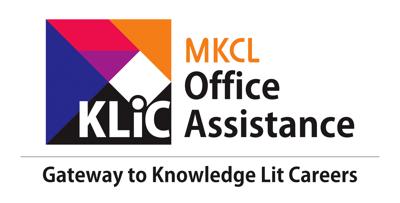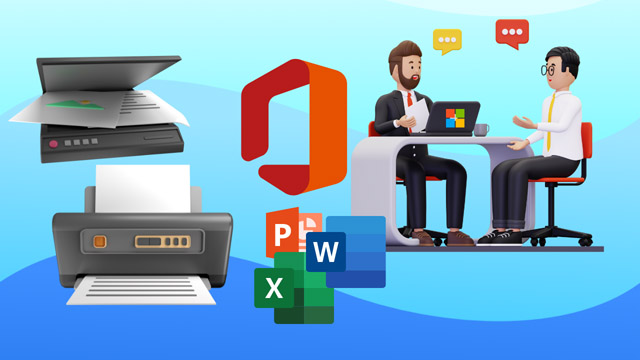- Understand the fundamentals of Microsoft Word including its interface and basic functionalities.
- Gain proficiency in navigating through various tabs and groups within the Word application.
- Develop skills to utilize Word's features effectively for document creation, formatting, and editing.
- Understand the fundamental elements and purposes of various business design materials such as business cards, letterheads, envelopes, feedback forms, portfolios, resumes, and more.
- Develop proficiency in creating professional business design materials using Microsoft Word, including formatting, layout, and design techniques.
- Learn practical tips and techniques for effective business communication through the design and creation of various documents and materials.
- Students will be able to demonstrate a comprehensive understanding of the purpose, significance, and standard formats of various business documents, such as business cards, letterheads, envelopes, portfolios, resumes with cover letters, employee shift schedules, contracts, business proposals, and labels.
- Students will proficiently utilize Microsoft Word to create, format, and customize diverse business documents according to industry standards and organizational requirements.
- Students will produce high-quality business documents that effectively convey information, establish a professional image, and facilitate seamless communication within the business environment.
- Gain a comprehensive understanding of the PowerPoint interface, including navigation, tools, and commands.
- Efficiently navigate through different tabs, groups, and options within the PowerPoint application.
- Proficiency in utilizing various features and functionalities offered by PowerPoint, such as formatting text, inserting media, creating animations, and applying transitions.
- Practice hands-on exercises to reinforce their understanding of PowerPoint features and enhance their skills in creating visually engaging presentations.
- Learn principles of effective presentation design, including layout, color schemes, typography, and visual hierarchy.
- Develop strategies for delivering engaging and impactful presentations, incorporating techniques for audience engagement, storytelling, and effective communication.
- Understand the fundamental concepts and components of various professional tools and materials used in job readiness, including startup plans, business cards, visual resumes, danglers, marketing plans, social media content, storyboards, lesson planners, posters, architectural portfolios, studio production plans, product roadmaps, infographics, and eContent.
- Develop proficiency in using Microsoft PowerPoint as a versatile tool for creating a variety of professional materials, from startup plans to infographics, and learn how to leverage its features effectively.
- Apply critical thinking and problem-solving skills to tailor and enhance professional materials according to specific business needs and target audiences, fostering adaptability and creativity in preparing for employment opportunities.
- Comprehend the concept of a startup, the significance of a startup plan in launching a new business, and the essential elements required for effective planning.
- Develop proficiency in visual communication by creating visual resumes, business cards, danglers, hang tags, posters, and architectural portfolios using MS PowerPoint.
- Gain insight into marketing planning, including audience analysis, research methodologies, and the creation of marketing plans using PowerPoint.

MS Word and MS PowerPoint Basics
Understand word processing and build visually engaging presentations.
Introduction
What you'll learn ?
- Navigate the Microsoft Word interface with ease, distinguishing between various tabs, groups, and commands.
- Demonstrate proficiency in using Word's features for formatting text, paragraphs, and documents, including font and style options.
- Illustrate advanced functions such as inserting tables, illustrations, references, and performing mail merges to create professional-quality documents.
- Conceptualize, design, and create a variety of business design materials using Microsoft Word, including business cards, letterheads, envelopes, feedback forms, portfolios, resumes, and more.
- Understand the importance of professional design in business communication and branding, and how to effectively utilize Microsoft Word to achieve desired outcomes.
- Possess the skills and knowledge necessary to produce high-quality, visually appealing business documents and materials that contribute to their professional success and organizational objectives.
- Assess understanding of the concepts, principles, and best practices related to business document creation and Microsoft Word usage through quizzes, assignments, and practical exercises.
- Evaluate students' ability to apply learned skills and techniques in designing and formatting various business documents, such as business cards, letterheads, envelopes, portfolios, resumes with cover letters, employee shift schedules, contracts, business proposals, and labels.
- Measure the effectiveness of students' communication and presentation skills in conveying information through well-designed and professionally crafted business documents.
- Demonstrate proficiency in navigating the PowerPoint interface, accessing various tabs, groups, and commands with ease.
- Efficiently utilize tools and functionalities within the PowerPoint application to enhance their productivity and workflow.
- Create visually appealing and professional presentations using advanced formatting techniques, multimedia integration, and design principles.
- Produce presentations that effectively communicate ideas, engage the audience, and convey information with clarity and impact.
- Develop confidence and proficiency in delivering presentations, employing techniques for effective communication, audience interaction, and overcoming nervousness.
- Deliver presentations that are well-structured, engaging, and tailored to the needs and preferences of diverse audiences.
- Demonstrate proficiency in creating a wide range of professional materials, including startup plans, visual resumes, marketing plans, social media content, posters, architectural portfolios, product roadmaps, infographics, and eContent, using Microsoft PowerPoint.
- Gain a comprehensive understanding of the importance and relevance of various professional tools and materials in job readiness and business development, enabling them to effectively communicate their skills and ideas in a professional setting.
- Ability to analyze business requirements, identify appropriate tools and techniques for creating professional materials, and adapt their approach to meet diverse business needs, thereby enhancing their readiness for employment and entrepreneurship opportunities.
- Demonstrate the ability to apply theoretical concepts of startup planning and marketing strategy development to real-world scenarios through practical exercises and assignments.
- Master the use of MS PowerPoint as a versatile tool for creating various visual communication materials, enhancing their technical skills for office productivity.
- Showcase creativity and innovation in designing visual resumes, marketing plans, and other materials, fostering a mindset for effective communication and problem-solving in modern workplaces.
- Table of content
Syllabus
- Introduction & User Interface
- File Tab
- Home Tab
- Insert Tab
- Draw Tab
- Design Tab
- Layout Tab
- Reference Tab
- Mailing Tab
- Review Tab
- View Tab
- Help Tab
- Business Card
- Letterhead
- Envelopes
- Feedback Forms
- Portfolio
- Resume with a Cover Letter
- Employee Shift Schedule
- Contracts
- Business Proposals
- Labels
- Performance Development Plan
- Project Report
- Certificate - Employee of the Month
- Invitations
- Hoardings/Gantries/Billboards
- Banners
- Flyer
- Brochure
- Social media marketing plan
- Product Catalog
- Introduction & User Interface
- Home Tab
- Insert Tab
- Design Tab
- Transitions Tab
- Animation Tab
- Slide Show Tab
- Review Tab
- View Tab
- Startup Plan (without physical setup)
- Business Cards
- Visual Resume
- Danglers and Hang Tags
- Marketing Plan
- Social Media Images or Posts
- Storyboard
- Lesson Planner
- Poster
- Architectural Portfolio
- Studio Production Plan
- Product Roadmap
- Infographics
- Rapid eContent creation
Certificate
- MKCL provides certificate (for 30/60/90 hours courses) to the KLiC learner after his/her successful course completion.
Academic Approach
The Academic Approach of the course focuses on the “work centric” education i.e. begin with work (and not from a book !), derive knowledge from work and apply that knowledge to make the work more wholesome, useful and delightful. The ultimate objective is to empower the Learner to engage in socially useful and productive work. It aims at leading the learner to his/her rewarding career as well as development of the society.
Learning methodology
- Learners are given an overview of the course and its connection to life and work.
- Learners are then exposed to the specific tool(s) used in the course through the various real-life applications of the tool(s).
- Learners are then acquainted with the careers and the hierarchy of roles they can perform at workplaces after attaining increasing levels of mastery over the tool(s).
- Learners are then acquainted with the architecture of the tool or Tool Map so as to appreciate various parts of the tool, their functions and their inter-relations.
- Learners are then exposed to simple application development methodology by using the tool at the beginner’s level
- Learners then perform the differential skills related to the use of the tool to improve the given ready-made outputs.
- Learners are then engaged in appreciation of real-life case studies developed by the experts.
- Learners are then encouraged to proceed from appreciation to imitation of the experts.
- After imitation experience, they are required to improve the expert’s outputs so that they proceed from mere imitation to emulation.
- Finally, they develop the integral skills involving optimal methods and best practices to produce useful outputs right from scratch, publish them in their ePortfolio and thereby proceed from emulation to self-expression.
Evaluation Pattern
Evaluation Pattern of KLiC Courses consists of 4 Sections as per below table:
| Section No. | Section Name | Total Marks | Minimum Passing Marks |
|---|---|---|---|
| 1 | Learning Progression | 25 | 10 |
| 2 | Internal Assessment | 25 | 10 |
| 3 | Final Online Examination | 50 | 20 |
| Total | 100 | 40 | |
| 4 | SUPWs (Socially Useful and Productive Work in form of Assignments) | 5 Assignments | 2 Assignments to be Completed & Uploaded |
MKCL’s KLiC Certificate will be provided to the learner who will satisfy the below criteria:
- Learners who have successfully completed above mentioned 3 Sections i.e. Section 1, Section 2 and Section 3
- Additionally, learner should have completed Section 4 (i.e. Section 4 will comprise of SUPWs i.e. Socially Useful and Productive Work in form of Assignments)
- Learner has to complete and upload minimum 2 out of 5 Assignments
Courses Fee Structure from 01 July, 2025 Onwards
KLiC 60 hour course fee applicable from 01 July, 2025 all over Maharashtra| KLiC Course Duration | MFO: MKCL Share (Including 18% GST) |
ALC Share (Service Charges to be collected by ALC) |
|---|---|---|
| 60 hours | Rs. 500/- | Rs. 2,500/- |
Important Points:
* Above mentioned fee is applicable for all Modes of KLiC Courses offered at Authorised Learning Center (ALC) and at Satellite Center
* Total fee is including of Course fees, Examination fees and Certification fees
* MKCL reserves the right to modify the Fee anytime without any prior notice
* Above mentioned fee is applicable for all Modes of KLiC Courses offered at Authorised Learning Center (ALC) and at Satellite Center
* Total fee is including of Course fees, Examination fees and Certification fees
* MKCL reserves the right to modify the Fee anytime without any prior notice
KLiC Courses Fee Structure upto 30 June, 2025
| Region | Total Fee (Rupees) |
| MMRDA, PMRDA and Rest of Maharashtra | 3000/- |
Important Points:
* Above mentioned fee is applicable for all Modes of KLiC Courses offered at Authorised Learning Center (ALC) and at Satellite Center
* Total fee is including of Course fees, Examination fees and Certification fees
* MKCL reserves the right to modify the Fee anytime without any prior notice
* Above mentioned fee is applicable for all Modes of KLiC Courses offered at Authorised Learning Center (ALC) and at Satellite Center
* Total fee is including of Course fees, Examination fees and Certification fees
* MKCL reserves the right to modify the Fee anytime without any prior notice
